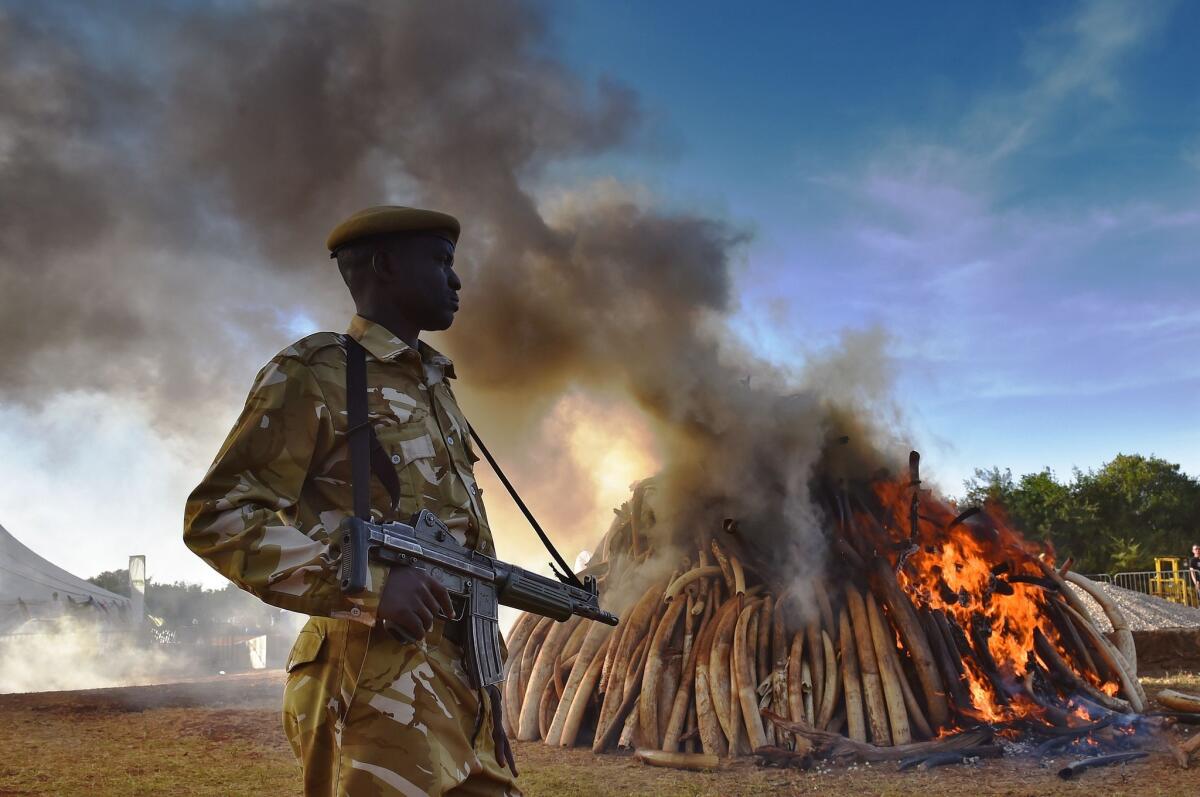San Diego Zoo, Kenyan conservancy discuss creating ‘elephant orphanage’

A security officer in Kenya guards a burning pile of 15 tons of seized elephant ivory. The fire was lit by Kenyan President Uhuru Kenyatta to mark World Wildlife Day and African Environment Day on March 3.
- Share via
reporting from San Diego — With elephants facing possible extinction due to poaching, San Diego Zoo officials and the operator of a wildlife conservancy in Africa are discussing the possibility of starting an “elephant orphanage” in Kenya.
Although no agreement has been reached, Ian Craig, founder of the Kenya-based Lewa Wildlife Conservancy, discussed the idea with zoo officials this week while he was in San Diego to attend the Endangered Species Day Celebration at the zoo’s Safari Park.
The zoo, with conservation projects worldwide, has a long history with Kenya’s Northern Rangelands Trust, also founded by Craig. Over nine years, the zoo has contributed more than $500,000 to community-based conservation efforts in the region.
Craig said he envisioned an exchange of elephant keepers between the San Diego Zoo and Kenya, with each side learning from the other. In the end, however, it will take greater action by more African nations to stop poaching, he said.
“There’s a chance we can avoid extinction but there is no quick fix,” he said. “We need to get on it quickly.”
Kenya has made significant progress in blocking poaching, Craig said, but other African nations, including Tanzania, Mozambique and Uganda, have not. “It’s very bad there,” he said.
A study published last year in the Proceedings of the National Academy of Sciences estimated that poachers killed 100,000 elephants across Africa between 2010 and 2012. A decade ago, 25% of elephant deaths were due to poaching, now that figure is 65%, which could lead to extinction, the study concluded.
“Elephants are under seige throughout Africa,” said a recent story in the New Yorker magazine. “Demand for ivory is increasing in Asia: once prized by Chinese aristocrats, it is now sought by members of China’s growing middle class, who buy ivory cigarette holders, chopsticks, and even carved miniature elephants.”
In Hong Kong, ivory can sell for $3,000 a pound, a pair of carved tusks for $200,000, the story said.
Much of the poaching, the story by Peter Canby in the magazine’s May 11 edition said, is done by organized crime figures with links to terrorist groups, armed with military weapons.
Given the matriarchal aspect of elephant herds, the death of female elephants is considerably troublesome, and thus the need for a facility to care for orphaned calves, Craig said in a telephone interview Friday from the Safari Park.
Craig converted his family’s 40,000-acre cattle ranch in Kenya into a conservancy that serves as a sanctuary for elephants and another species endangered by poaching, rhinoceroses. A Rally 4 Rhinos was held during the Safari Park celebrations.
“Those are the wars I’ve chosen to fight,” Craig said.
More to Read
Sign up for Essential California
The most important California stories and recommendations in your inbox every morning.
You may occasionally receive promotional content from the Los Angeles Times.













